Click on images to enlarge
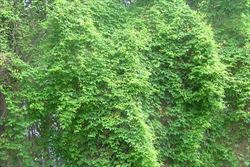
large infestation smothering trees (Photo: Sheldon Navie)
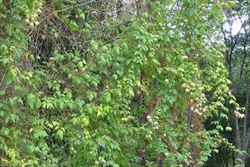
infestation (Photo: Sheldon Navie)

habit (Photo: Sheldon Navie)
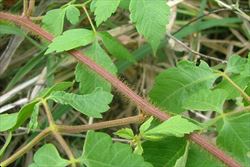
close-up of stems covered in yellowish hairs (Photo: Sheldon Navie)
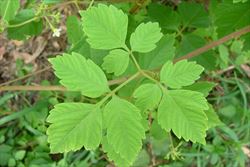
compound leaf, with three lots of three leaflets (Photo: Sheldon Navie)
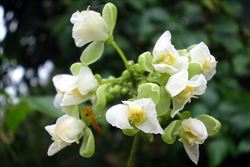
flower cluster (Photo: Sheldon Navie)
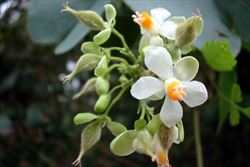
close-up of flowers and young fruit (Photo: Sheldon Navie)
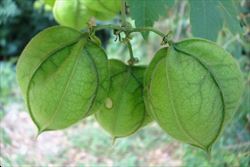
close-up of immature fruit (Photo: Sheldon Navie)
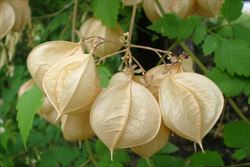
mature fruit (Photo: Sheldon Navie)
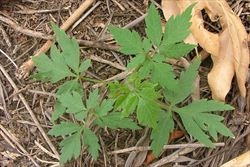
seedling (Photo: Sheldon Navie)
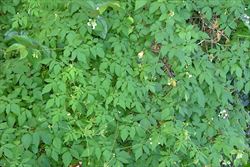
scrambling habit (Photo: Sheldon Navie)
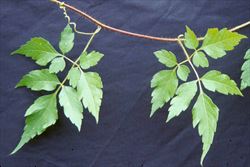
stem with leaves and tendrils (Photo: Biosecurity Queensland, QDPI&F)
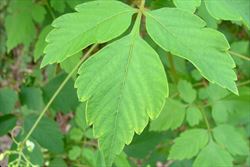
close-up of the toothed leaflets (Photo: Sheldon Navie)
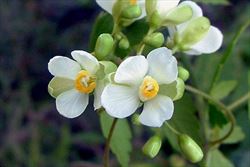
close-up of flowers and flower buds (Photo: Sheldon Navie)
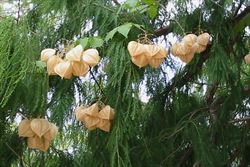
clusters of mature fruit (Photo: Sheldon Navie)
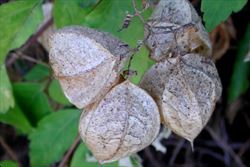
close-up of old fruit (Photo: Sheldon Navie)
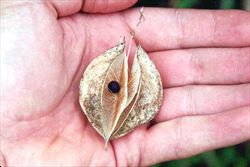
close-up of fruit showing seed (Photo: Biosecurity Queensland, QDPI&F)
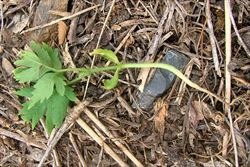
uprooted seedling, showing seed-leaves (Photo: Sheldon Navie)

the smaller leaves, fruit and flowers of small balloon vine, Cardiospermum halicacabum (Photo: Carl Hunter and USDA PLANTS Database).
Scientific Name
Cardiospermum grandiflorum Sweet
Synonyms
Cardiospermum hirsutum Willd.
Family
Sapindaceae
Common Names
balloon vine, balloonvine, heart seed vine, heartseed, heart-seed vine, heartseed vine, heartseedvine, large balloon creeper, showy balloon vine, showy balloonvine
Origin
Considered to be native to the tropical regions of the Americas and Africa (i.e. pan-tropical). It may have originated in tropical South America (i.e. in Brazil and north-eastern Argentina) and may have been an early introduction into Africa.
Cultivation
Though it may have been grown as a garden plant in the past, balloon vine (Cardiospermum grandiflorum) is generally not deliberately cultivated any more.
Naturalised Distribution
This species is widely distributed in the coastal and sub-coastal regions of eastern Australia. It is very common in south-eastern Queensland and north-eastern New South Wales. Scattered throughout the coastal areas of central and northern Queensland and central and southern New South Wales. Also recorded in south-western Western Australia (i.e. near Perth).
Also naturalised in the Canary Islands, Micronesia and Hawaii (possibly also in Africa).
Habitat
This climbing plant is most commonly found growing over the vegetation lining creeks and rivers. It is also a weed of forests and forest margins, urban bushland, open woodlands, roadsides, fence-lines, disturbed sites, waste areas and neglected gardens in tropical, sub-tropical and warmer temperate regions.
Habit
A long-lived (i.e. perennial) climbing plant that has the ability to cover trees (i.e. grows up to 8 m or more in height).
Distinguishing Features
- a climbing plant with stems that are usually covered with stiff hairs when they are young.
- its leaves are compound, with leaflets arranged in three groups of three, and often have a tendril in their forks.
- the leaflets (2-8 cm long and 1-5 cm wide) have coarsely toothed margins.
- its small white flowers are borne in clusters at the end of stalks that have two small curved tendrils near their tips.
- its very distinctive large, balloon-shaped, papery capsules (45-65 mm long and 30-45 mm wide) have three compartments, each containing a single hard seed.
Seedling
Its seedlings have two fleshy, green, seed leaves (i.e. cotyledons) and their stems are very hairy. The first pair of true leaves are less divided than the adult leaves and usually have three leaflets, each with three deeply-cut lobes.
Stems and Leaves
The stems are ribbed lengthwise (i.e. longitudinally) and are usually covered with stiff yellowish or reddish coloured hairs, particularly when they are young.
The leaves are alternately arranged along the stems, often with a tendril in their forks (i.e. axils), and are borne on stalks (i.e. petioles) 2-10 cm long. They are compound, with leaflets arranged in three groups of three (i.e. they are biternate). The leaflets (2-8 cm long and 1-5 cm in wide) are roughly egg-shaped in outline (i.e. ovate) with pointed tips (i.e. acuminate apices) and coarsely toothed (i.e. serrated) margins. The uppermost (i.e. terminal) leaflet of each group of three is usually significantly larger than the two side (i.e. lateral) leaflets. The leaves are somewhat hairy (i.e. pubescent), particularly on their lower surfaces.
Flowers and Fruit
The flowers are borne in small clusters (about 35 mm long) at the end of hairy stalks (i.e. peduncles) that can be from 5 to 30 cm long. These stalks (i.e. peduncles) are produced in the upper leaf forks (i.e. axils) and possess two small curved tendrils near their tips (i.e. apices). Each of the white flowers is borne on a short stalk (i.e. pedicel) about 5 mm long and has four petals (6-11 mm long) and several yellow stamens. They also have four sepals that are arranged in pairs, the outer pair are smaller (about 2 mm long) while the inner pair are significantly larger (8-9 mm long). Flowering may occur throughout the year, but is most abundant from summer through to winter.
The fruit are relatively large (45-65 mm long and 30-45 mm wide), inflated, balloon-shaped, papery capsules with a shortly pointed tip (i.e. apiculate apex). They have three compartments (i.e. carpels), and each compartment produces a single seed. The surfaces of these fruit are somewhat ribbed and sparsely covered in small hairs (i.e. they are puberulent). They are initially green in colour, but turn straw-coloured and then darken with age. The relatively large (6-7 mm long) seeds are rounded (i.e. globose), hard, black, and have a small circular structure (i.e. aril) near their base.
Reproduction and Dispersal
This species reproduces mainly by seed contained within its light papery fruit. The fruit are most commonly dispersed by wind and water. They may also be spread in dumped garden waste.
Environmental Impact
Balloon vine (Cardiospermum grandiflorum) is a significant environmental weed in eastern New South Wales and south-eastern Queensland, and is currently listed as a priority environmental weed in four Natural Resource Management Regions.
It is common along creeks, near the margins of rainforests, and in moist gullies in the coastal districts of Queensland and New South Wales. It also grows along disturbed creeklines in south-western Western Australia. Balloon vine (Cardiospermum grandiflorum) grows rapidly into the tops of trees and can smother and kill trees, shrubs and groundcover plants. It forms a thick curtain of stems and leaves which excludes light and inhibits photosynthesis in the native plants below. The weight of this vegetation can also contribute to canopy collapse and ecosystem destruction. Balloon vine (Cardiospermum grandiflorum) can be seen growing in most of the riverine rainforest remnants around Brisbane. These rainforest remnants are small and any reduction of their edges exposes them to greater risk of weed invasion and a number of other threats. This species is also one of the exotic vines that has resulted in "invasion of exotic vines and scramblers" being declared a "key threatening process" in New South Wales.
It is also considered to be very invasive and widespread on Rarotonga, in the Cook Islands.
Other Impacts
Dense infestations can also impede access, increase the risk and intensity of fires and harbour pests an diseases.
Legislation
This species is declared under legislation in the following states and territories:
- New South Wales: Class 4 - a locally controlled weed. The growth and spread of this species must be controlled according to the measures specified in a management plan published by the local control authority and the plant may not be sold, propagated or knowingly distributed (in the Campbelltown, Hornsby, Hunters Hill, Ku-ring-gai, Lane Cove, Manly, Mosman, Parramatta, Ryde, Warringah and Willoughby local authority areas).
- Queensland: Class 3 - this species is primarily an environmental weed and a pest control notice may be issued for land that is, or is adjacent to, an environmentally significant area (throughout the entire state). It is also illegal to sell a declared plant or its seed in this state.
- Western Australia: Unassessed - this species is declared in other states or territories and is prohibited until assessed via a weed risk assessment (throughout the entire state).
Management
For information on the management of this species see the following resources:
- the Biosecurity Queensland Fact Sheet on this species, which is available online at http://www.dpi.qld.gov.au.
Similar Species
Balloon vine (Cardiospermum grandiflorum) is very similar to another closely related species known as small balloon vine (Cardiospermum halicacabum ). These two species can be distinguished by the following differences:
- balloon vine (Cardiospermum grandiflorum) has relatively large leaves (6-16 cm long) and densely hairy younger stems. Its flowers (6-11 mm long) and papery capsules (5-6.5 cm long) are also relatively large.
- small balloon vine (Cardiospermum halicacabum) has relatively small leaves (4-12 cm long) and finely hairy to almost hairless (i.e. puberulent to sub-glabrous) younger stems. Its flowers (3-4 mm long) and papery capsules (1-3 cm long) are also relatively small.
The native plant known as slender grape (Cayratia clematidea) is also relatively similar, but has five leaflets on each leaf and its fruit is a small black berry.

